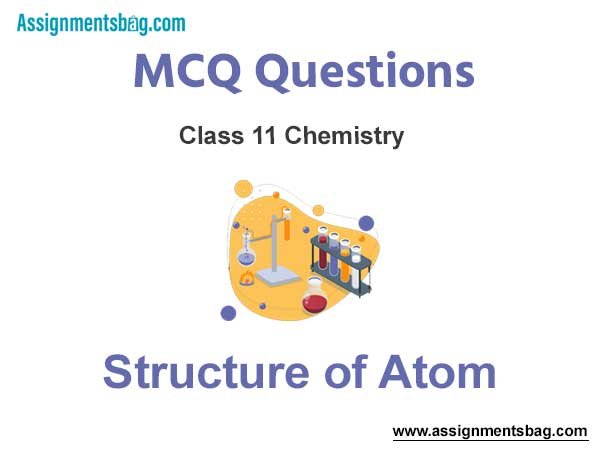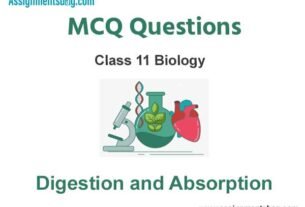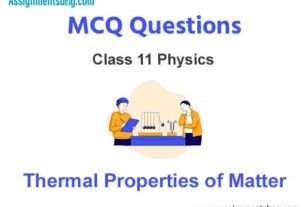Please refer to MCQ Questions Chapter 2 Structure of Atom Class 11 Chemistry with answers provided below. These multiple-choice questions have been developed based on the latest NCERT book for class 11 Chemistry issued for the current academic year. We have provided MCQ Questions for Class 11 Chemistry for all chapters on our website. Students should learn the objective based questions for Chapter 2 Structure of Atom in Class 11 Chemistry provided below to get more marks in exams.
Chapter 2 Structure of Atom MCQ Questions
Please refer to the following Chapter 2 Structure of Atom MCQ Questions Class 11 Chemistry with solutions for all important topics in the chapter.
MCQ Questions Answers for Chapter 2 Structure of Atom Class 11 Chemistry
Question. The triad of the nuclei that is isotonic, is
(a) 6c14‘ 7N14‘ 9F19
(b) 6c14‘ 7N15‘ 9F17
(c) 7c14‘ 7N14‘ 9F17
(d) 6c12‘ 7N14‘ 9F19
Answer
B
Question. Which of the following are iso-electronic?
(a) Li and Be+
(b) H– and He+
(c) He and H
(d) Be+ and H
Answer
A
Question. Mg 2+ is isoelectronic with
(a) Cu 2+
(c) Na+
(b) Zn 2+
(d) Ca2+
Answer
C
Question. The number of electrons and neutrons of an element is 18 and 20, respectively. Its mass number is
(a) 2
(b) 17
(c) 37
(d) 38
Answer
D
Question. Which one of the following ions is not isoelectronic with O2- ?
(a) Ti+
(b) Na+
(c) F–
(d) N3-
Answer
A
Question. An elements
(a) is one type of atom
(b) is two or more types of atom
(c) has constant boiling point
(d) has constant melting point
Answer
A
Question. An isotone of 7632 Ge is
(a) 7732 Ge
(b) 7733 Ge
(c) 7734 Ge
(d) 7836 Ge
Answer
B
Question. Which of the following relation is incorrect regarding Bohr’s theory?
(a) Velocity of electron ∝ 1/n
(b) Frequency of revolution ∝ 1/n2
(c) Radius oforbit ∝ n2Z
(d) Force on electron ∝ 1/n4
Answer
C
Question. The frequency of radiation emitted when the electron falls from n = 4 to n = 1 in a hydrogen atom will be (given, ionisation energy of H=2.18×10–18 J atom-1 and h = 6. 625 X 10-34 Js)
(a) 1.54 x 1015 s-1
(b) 1.03 x 1015 s-1
(c) 3.08 x 1015 s-1
(d) 2.00 x 1015 s-1
Answer
C
Question. The ionisation energy of hydrogen atom is 13.6 eV. What will be the ionisation energy of He+ ?
(a) 13.6 eV
(b) 54.4 eV
(c) 122.4eV
(d) Zero
Answer
B
Question. The wavelength of the radiation emitted, when in a hydrogen atom electron falls from infinity to stationary state 1, would be (Rydberg constant= 1.097 x 107 m-1)
(a) 91 nm
(b) 192 nm
(c) 406nm
(d) 9.l x 10-8 nm
Answer
A
Question. For a Bohr atom angular momentum M of the electron is (n = 0, 1, 2, …. )
(a) nh2/4π
(b) n2h2/4π
(c) √nh2/4π
(d) nh/2π
Answer
D
Question. The velocity of electron in first orbit compared to the velocity of light is of H-atom asI l
(a) 1/10 th
(b) 1/100 th
(c) 1/1000 th
(d) same
Answer
B
Question. Stark effect refers to the
(a) splitting up of the lines in an emission spectrum in the presence of an external electrostatic field
(b) random scattering of light by colloidal particles
(c) splitting up of the lines in an emission spectrum in a magnetic field
(d) emission of electrons from metals when light falls upon them
Answer
A
Question. The emission spectrum of hydrogen discovered first and the region of the electromagnetic spectrum in which it belongs, respectively are
(a) Lyman, ultraviolet
(b) Lyman, visible
(c) Balmer, utraviolet
(d) Balmer, visible
Answer
D
Question. Ionisation energy of He+ is 19 . 6 x 10-18 J atom-1 • The energy of the first stationary state (n = I) of Li2+ is
(a) 4 . 41 X 10-16 Jatom-1
(b) – 4. 4lx 10-17 Jatom-1
(c) – 2 . 2 x 10-15 Jatom-1
(d) 8 . 82x 10-17 Jatom-1
Answer
B
Question. The radius of the first Bohr orbit of hydrogen atom is 0.529A. The radius of the third orbit of H+ will be
(a) 8.46 Å
(b) 0.705 Å
(c) 1.59 Å
(d) 4.76 Å
Answer
D
Question. The wave number of the spectral line in the emission spectrum ofhydrogen will be equal to~ times the Rydberg’s 9 constant, if the electron jumps from
(a) n = 3 to n = l
(b) n = 10 to n =l
(c) n = 9 to n = l
(d)n = 2 to n = l
Answer
A
Question. The H-spectrum show
(a) Heisenberg’s uncertainty principle
(b) diffraction
(c) polarisation
(d) presence of quantised energy level
Answer
D
Question. Which of the following statements does not form a part of Bohr’s model of hydrogen atom?
(a) Energy of the electrons in the orbit is quantised
(b) The electron in the orbit nearest the nucleus has the lowest energy
(c) Electrons revolve in different orbits around the nucleus
(d) The position and velocity of the electrons in the orbit cannot be determined simultaneously
Answer
D
Question. Energy ofH-atom in the ground state is – 13. 6eV, hence energy in the second excited state is
(a) -6.8eV
(c) – l.5leV
(b) – 3.4eV
(d) – 4 .53eV
Answer
C
Question. Uncertainty in the position of an electron (mass = 9.1 x 10- 31 kg)moving with a velocity 300ms- 1 , accurate upon 0. 00 l % will be (h = 6. 63 x 10-34 Js)
(a) 19.2 x 10-2 m
(b) 5.76 x 10-2 m
(c) 1.93 x 10-2 m
(d) 3.84 x 10-2 m
Answer
C
Question. The probability of finding the electron in the orbital is
(a) 100%
(b) 90-95%
(c) 70-80%
(d) 50-60%
Answer
B
Question. What is the frequency of photon whose momentum is 1.1 X 10-23 kg ms-2 ?
(a) 5 X 1016 Hz
(b) 5 X 1017Hz
(c) 0.5 X 1018Hz
(d) 5 X 1018Hz
Answer
D
Question. For a /-orbital the values of mare
(a) – 1, 0, + 1
(b) 0, + 1, + 2, + 3
(c) -2, -1, 0, + 1, + 2
(d) – 3, – 2, – 1, 0, + 1, + 2, + 3
Answer
D
Question. The magnetic quantun1 nwnber ford-orbital is given by
(a) 2
(b) 0, ± 1, ± 2
(c) 0, 1, 2
(d) 5
Answer
B
Question. Which of the following restricted?
(a) n = 3, l = I, m = + 2
(c) n = 3, l = I, m = + 1
(b) n = 3, / = 1, m = 0
(d) m = 3, / = 1, m =-1
Answer
A
Question. What is the maximum number of electrons in an atom that can have the following quantum numbers n = 4, m1 = + 1?
(a) 4
(b) 15
(c) 3
(d) 6
Answer
D
Question. Which one of the following is the set of correct quantum numbers of an electron in 3d orbital ?
(a) n = 3, I = 0, m = 0, s = – 1/ 2
(b) n = 2, I = 3, m = 0, s = + 1/ 2
(c) n = 3, I= 1, m = 0, s = – 112
(d) n = 3, I = 2, m = l, s = + 1/ 2
Answer
D
Question. Electron density in the yz plane of 3d X2 –y2 orbital is
(a) zero
(b) 0.50
(c) 0.75
(d) 0.90
Answer
A
Question. Non-directional orbital is
(a) 4p
(b) 4d
(d) 4f
(d) 3s
Answer
D
Question. In a multi-electron atom, which of the following orbitals described by the three quantum numbers will have the same energy in the absence of magnetic and electric fields?
I. n = 1, I= 0, m = 0
Ill. n = 2, I= I, m = I
V. n = 3, / = 2, m = 0
TT. n = 2, / = 0, m = 0
TV. n = 3, / = 2, m = I
(a) (IV) and (V)
(b) (III) and (IV)
(c) (II) and (III)
(d) (I) and (IT)
Answer
A
Question. Which of the following statements in relation to the hydrogen atom is correct ?
(a) 3s, 3p and 3d-orbitals all have the same energy
(b) 3s and 3p-orbitals are oflower energy than 3d-orbital
(c) 3p-orbital is lower in energy than 3d-orbital
(d) 3s-orbital is lower in energy than 3p-orbital
Answer
A
Question. Which has the highest elm ratio ?
(a) He2+
(b) H+
(c) He+
(d) D+
Answer
B
Question. The nucleus of an atom contains
(a) proton and electron
(b) neutron and electron
(c) proton and neutron
(d) proton, neutron and electron
Answer
C
Question. The ratio of the difference in energy between the first and the second Bohr orbit to that between the second and the third Bohr orbit is
(a) 1/2
(b) 1/3
(c) 4/9
(d) 27/5
Answer
D
Question. The wave number of the first line in the Lyman series in hydrogen spectrum is
(a) 72755.5 cm-1
(b) 109678 cm-1
(c) 82258.5 cm-1
(d) 65473.6 cm-1
Answer
C
Question. Rutherford’s experiment on the scattering of a-particles showed for the ftrst time that the atom has
(a) electrons
(b) protons
(c) nucleus
(d) neutrons
Answer
C
Question. The energy of the electron in fast Bohr’s orbit is – 13. 6eV The energy of the electron in its ftrst excited state is
(a) – 3.4eV
(b) – 27.8eV
(c) – 6.8eV
(d) – 10.2eV
Answer
A
Question. Wave nature of electrons was demonstrated by
(a) Schrodinger
(b) de-Broglie
(c) Davisson and Garmer
(d) Heisenberg
Answer
B
Question. A body of mass 10 mg is moving with a velocity of 100 ms-1 • The wavelength of de-Broglie wave associated with it would be (h = 6. 63 X 10-34 J s)
(a) 6.63 x 10-35 m
(b) 6.63 x 10-34 m
(c) 6.63 x 10-31 m
(d) 6.63 x 10-37 m
Answer
C
Question. What accelerating potential is needed to produce an electron beam with an effective wavelength of0.090 Å?
(a) 1.86 x 104 eV
(b) 1.86 x 102 eV
(c) 2.86 x 104 eV
(d) 2.86 x 102 eV
Answer
A
Question. The uncertainties in the velocities of two particles A and B are 0.05 and 0.02 ms-1 respectively. The mass of Bis five times to that of mass A. What is the ratio of uncertainties ( ΔxA/ΔxB) in their positions ?
(a) 2
(c) 4
(b) 0.25
(d) 1
Answer
A
Question. Which combinations of quantum numbers n, l, m ands for the electron in an atom does not provide a permissible solution of the wave equation?
(a) 3,2, 1,1/ 2
(b) 3, l,1, – 1/2
(c) 3, 3, 1, – 1/ 2
(d) 3, 2, – 2, 1/ 2
Answer
C
Question. The orbital angular momentum of an electron revolving in a p -orbital is
(a) zero
(b) h/√2n
(c) h/2n
(d) 1/2 h/2n
(e) 2/2√2n
Answer
B
Question. Which one of the following set of quantum numbers is not possible for electron in the ground state of an atom with atomic number 19?
(a) n = 2, l = 0, rn = 0
(b) n = 2, l = I, rn = 0
(c) n = 3, l = 1, m = – I
(d) n = 3, l = 2, m = + 2
( e) n = 4, I = 0, m = 0
Answer
D
Question. For the valency electron in copper, the four quantum numbers are
(a) n = 4, I= 0, m = 0, s = II 2
(b) n = 4, l = 0, m = + 2, s = II 2
(c) n = 4, I= I, m = + 2, s = 112
(d) n = 4, l = 1, m = 0, s = 1/ 2
Answer
A
Question. The representation of the ground state electronic configuration of He by box – diagram is wrong because it violates
(a) Heisenberg’s uncertainty principle
(b) Bohr’s quantization theory of angular momenta
(c) Pauli exclusion principle
(d) Hund’s rule
Answer
C
Question. An electron is moving in Bohr’s fourth orbit. Its de-Broglie wavelength is A. What is the circumference of the fourth orbit?
(a) 2/λ
(b) 2λ
(c) 4λ
(d) 4/λ
Answer
C
Question. In an atom, the total number of electrons having quantwn nwnbers n = 4, I m1 I= land ms = – l / 2 is
(a) 3
(b) 2
(c) 6
(d) 9
Answer
A
Question. In an atom the order of increasing energy of electrons with quantun1 nwnbers
I. n = 4, I= I
II. n = 4, I= 0
III. n = 3, / = 2 and
IV. n = 3, I= 1 is
(a) III < I < IV < II
(c) I < III < II < IV
(b) II < IV < I < III
(d) IV < II < III < I
Answer
D
Question. lsoelectronic pair among the following is
(a) Ca and K
(b) Ar and Ca 2+
(c) K and Ca 2+
(d) Arand K
Answer
B

We hope you liked the above provided MCQ Questions Chapter 2 Structure of Atom Class 11 Chemistry with solutions. If you have any questions please ask us in the comments box below.


